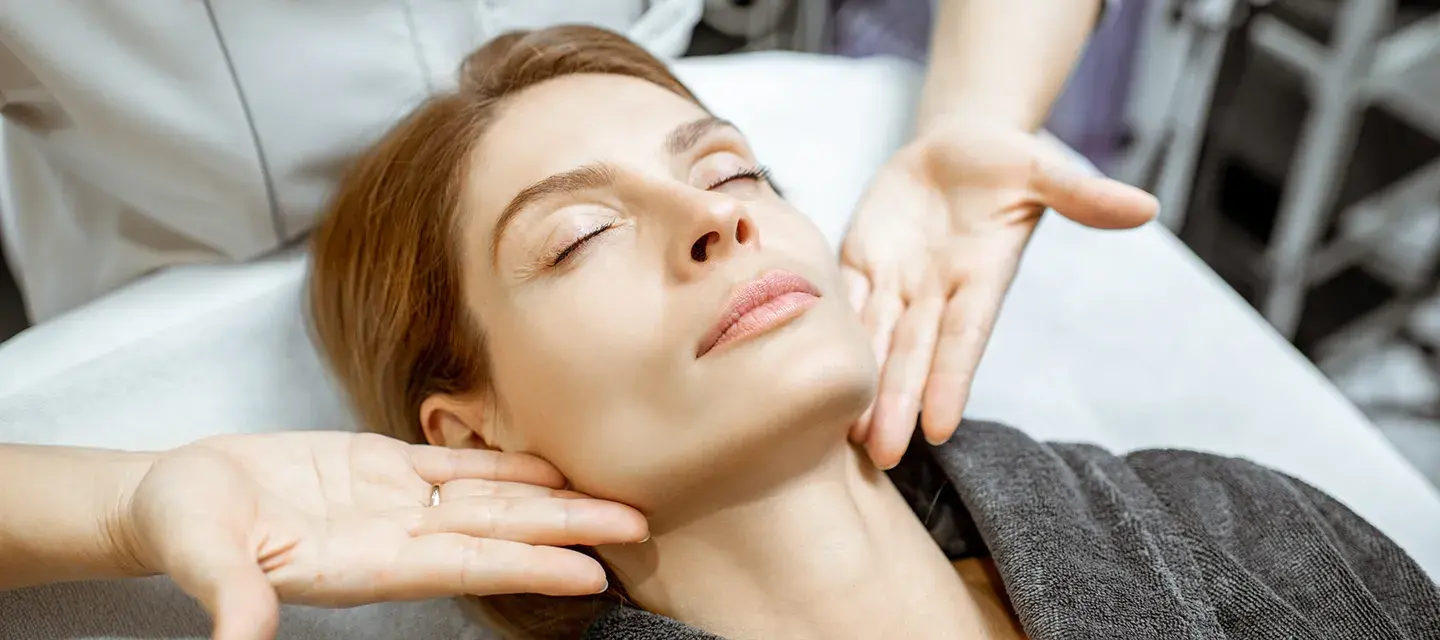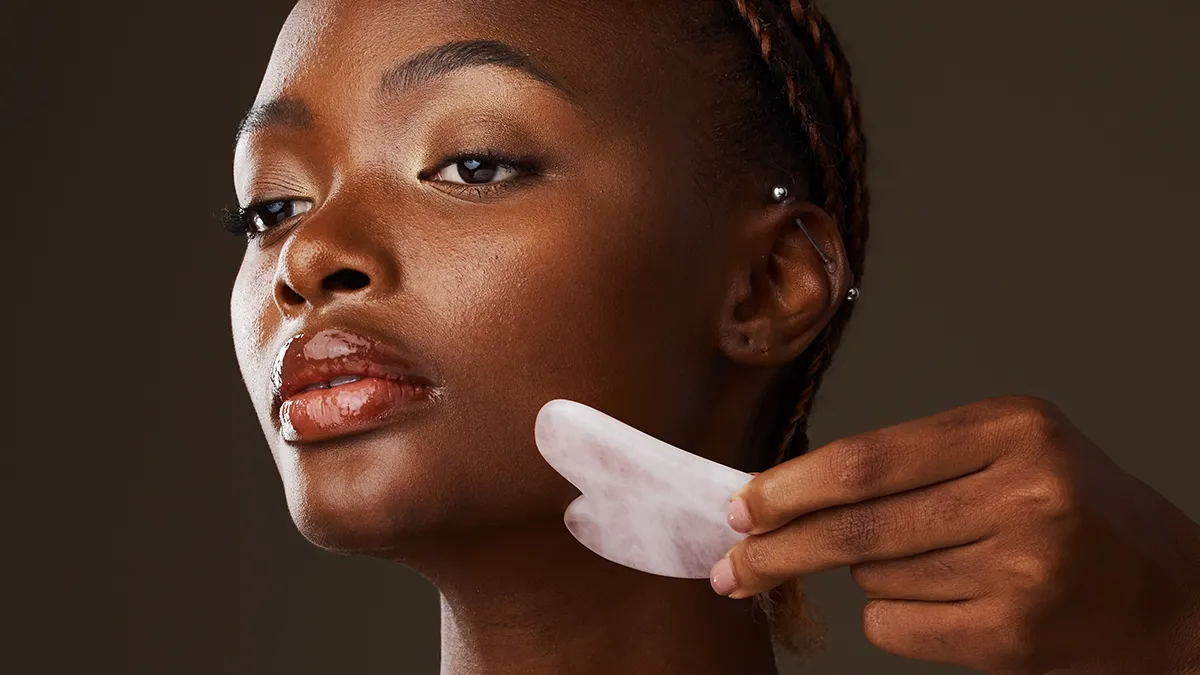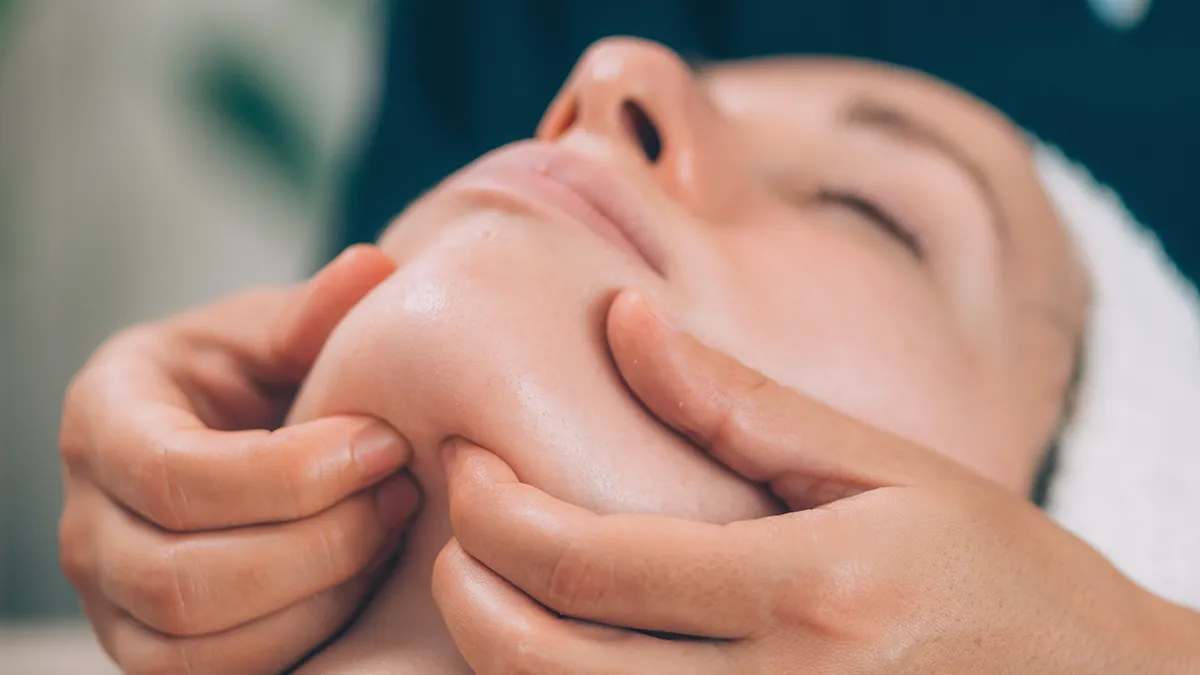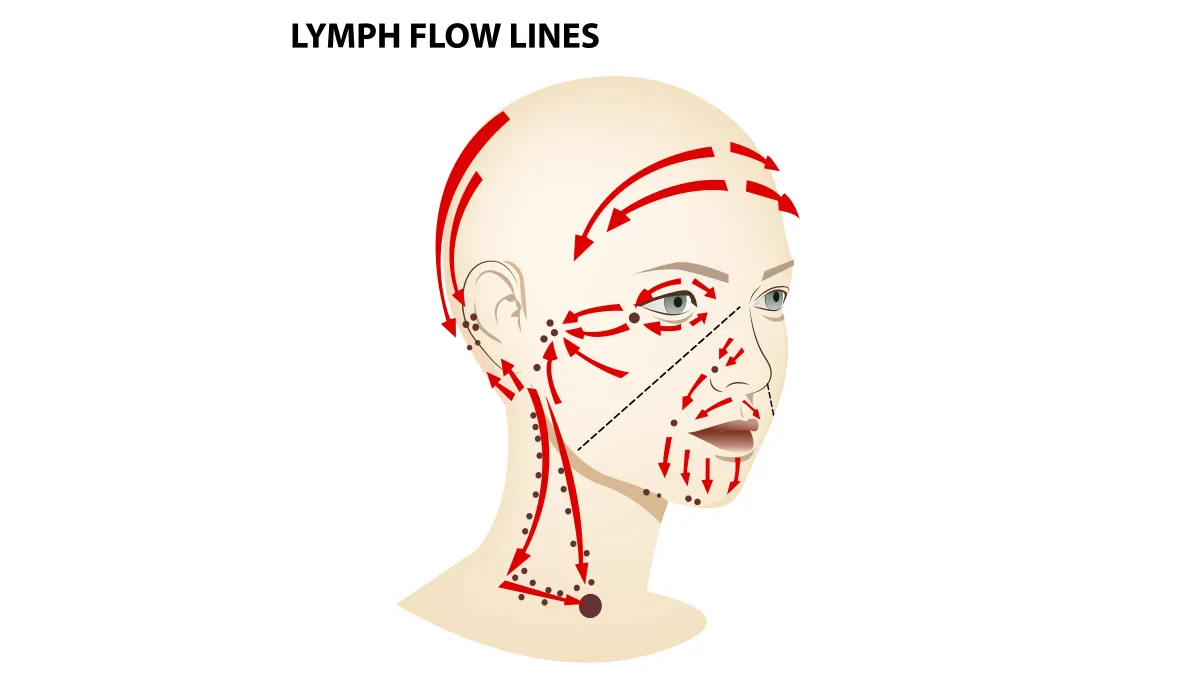14 min read
How to Do Lymphatic Drainage Massage on the Face: Benefits, Steps & Tools

Woke up puffy today like you're the freakin’ Marsmallow queen? Me too, and I dealt with it in a couple of minutes with a few well-calibrated lymphatic massage strokes at home. Skin health isn’t only about what we apply or put into our bodies — it’s also about how well our skin is able to remove toxins, circulate nutrients, and release trapped fluid.
There are things we know, things we don't know, and those we should know to take care of ourselves better. Lymphatic drainage massage on the face or the body is one of those things we should know. Why? Because lymphatic drainage massage for the face benefits go far beyond just a temporary aesthetic fix, such as depuffing. It is also very easy to learn and do alone at home in a few minutes to improve how we look and feel.
This is what we are going to do here today - offer a beginner-friendly guide to lymphatic drainage face massage basics. We'll talk about the main information, such as how the understanding of the lymph flow began, who brought it into modern medicine, how lymphatic massage works, how often to do it, and the key lymphatic drainage points on the face. We will also learn some key techniques, tools like jade rollers and gua sha stones, and explain the beauty benefits backed by science, while answering the most common questions, like whether it can really help with a double chin or facial swelling.
How did we get to modern lymphatic massage?
Who figured out that there is such a thing as a lymphatic system? The ancients, of course. I keep getting flabbergasted by how these people who hadn’t a morsel of the technology we have today managed to use their common sense and powers of observation to draw conclusions that will take millennia to confirm scientifically. But they did. The ancient Egyptians and the ancient Greeks figured that there was more than just blood flow going on by dissecting the deceased.
It took until the 17th century for Frederik Ruysch to inject air into vessels to demonstrate the presence of semilunar valves, which ensure a one-way flow of lymph, not allowing it to back up. He demonstrated the network of lymphatic vessels and lymph nodes within organs, setting up the foundation for Mascagni, who published the drawings of an entire lymphatic network in 1784. The introduction of radiological lymphography was a revolution, followed by more precise magnetic resonance imaging and near-infrared fluorescence lymphography, which allowed us to see the lymphatic system in much greater detail.
But the gentle rhythmic massage techniques we love and still use today, and which taught the world how to do lymphatic drainage massage on face and body, were developed by a Danish husband and wife, Dr. Emil and Estrid Vodder, in the '30s. This is not your regular massage that focuses more on deeper tissue like muscle, but was focused more on rhythm and pressure just enough to stretch and move the skin, because the lymphatic vessels are located nearer to the surface. And they used no lubricants such as massage oil, as they wanted the traction and easier manipulation of the skin and superficial tissues right below it to encourage healthy lymph flow if it had in any way been stalled or obstructed.
Although originally developed for swollen lymph nodes, lymphatic massage is now used for various conditions, such as reducing swelling (edema) and fluid retention, detoxification and post-operative recovery, supporting the immune system, minimizing pain, bruising, and scarring, as well as promoting relaxation and reducing stress. What a reminder of how powerful a light, but knowledgeable, touch can be. We were made to move and to be touched by others. Our entire physiognomy was built around it.
Understanding Lymphatic Drainage
Imagine the wealthiest city in the world, but with all the roads gridlocked. Technically, there is a potential for everyone to be content, get what they need, and go where they want to go, but the traffic won’t budge. No one can keep an appointment, the supermarket shelves are bare because the truck deliveries can’t pass, and the city is soon suffocating in garbage (the unavoidable product of life), while people are starting to go mad and riot. This is the gist of it. Lymph flow gets things where they need to be and takes away the metabolic garbage and the rowdy pathogens to keep the Youopollis functioning. Before we dive into techniques and tools, you need to know this.
Back to our puffy face now. Hardly the most pressing matter in the universe, but I do like to recognise myself in the mirror before I start the day. When everything is going smoothly, lymph in the body flows freely, keeping your face naturally de-puffed, cells nourished, and skin looking fresh and rosy. However, ideal is just a (perhaps sometimes temporarily attainable) concept. Life is complicated, and sometimes things don’t go as planned. We will have stress, sleepless nights (for fun or necessity), we will forget to drink water and get dehydrated, salty foods are delicious (let’s not lie), we’ll neglect basic skincare when we’re too tired to stand, or we will undergo hormonal fluctuations or medication side effects, such as water retention due to corticosteroids. This may all lead to facial congestion, puffiness, dull-looking skin, or that “I slept 12 hours and still look tired” feeling, when you know, you just know something is wrong.
How will you recognise poor lymphatic drainage in the face? When the lymph fluid isn’t moving as it should and doing its job, this will often show up as a swollen face in the morning. You can also notice tightness around the jaw, puffy eyes, which is very common due to the thinnest skin on the body, or a feeling of fullness in the cheeks, as if you were a hamster planning a great escape and have chosen to stash all of your food in your cheek pouches. So, the answer to “How do I know if my lymphatic system is clogged?” is usually, “Look in the mirror.” You’ll most likely see:
- Persistent swelling
- Bloating in the lower face region, where water retention pools due to gravity
- Breakouts from stagnating lymph and toxin accumulations
- Skin that looks less defined than usual, as if you’ve aged a few years overnight

And why can you notice the most pronounced symptoms of facial tension and puffiness in the morning? Because lymph responds to movement and the mechanical force of the muscles, which encourages proper flow (another benefit of exercise), and we’re stationary while we sleep with zero to very little muscle movement. This makes it much easier for lymph to stagnate and start causing problems.
Lymphatic Drainage Massage Face Benefits
If you start using a lymphatic drainage massage face tool or your hands, you’ll first begin to alleviate the problem you’re experiencing, but you’ll soon realize how good it feels. This is how people actually introduce lymphatic drainage into their skincare routine. They just feel better and enjoy the pressure, and a few knowledgeable swoops get stuck in their regular daily skincare routine. We all know how fast we’re done with our routine on a regular Tuesday morning. So, what will be the noticeable face massage benefits?
- Reduced facial puffiness and swelling around the eyes, cheeks, and under the chin
- Improved skin tone and texture
- Double chin and jawline contour improvement due to the release of trapped fluid that softens the sharp face contours, which we so readily associate with youth, being in shape, and being healthy.
- Boost circulation and give the skin a natural glow (no highlighter needed) thanks to better nutrient circulation and oxygenation. If you can't get good nutrition and freshly oxygenated blood to the skin cells, they will get dull and gray, barely surviving.
- Help release facial tension from stress, jaw clenching, bruxism (teeth grinding at night), or tech-neck posture
- Support detox pathways if they have become sluggish or blocked, which can help manage breakouts or dullness that result from lymphatic stagnation for too long.
This is just physiology. The body needs to move, and everything in the body needs to move too. When lymph fluid moves, the face looks thinner, more sculpted, and fresher. When it stagnates, we feel heavy, puffy, dull, congested, or inflamed. You can think of your lymph massage as a regular mini deep clean for the skin and tissues below that will have not only aesthetic benefits but far-reaching health benefits, if you do it consistently and correctly. Dr and Mrs Vodder would be so proud of us, learning the principles from their life’s work to help ourselves.
So, does lymphatic drainage massage work on the face? Yes, it really does - instantly for puffiness and in time and practice for skin texture and tone. One massage will not give you a Zoolander jaw, but the more regularly you encourage lymph flow, the less fluid retention returns.

How often should you do lymphatic drainage massage on face?
You can do a facial lymphatic drainage massage daily if you’re doing it gently and feel the need to do so, but listen to your body. It should feel good and invigorating. You should also be aware of contraindications, such as infections and active cancer in the area being massaged, or heart/kidney issues (which may be the reason you’re retaining unusual amounts of water in the face and body), and refrain from using these techniques without consulting a doctor.
Just a few minutes a day can be really beneficial, but as a starting point, experts recommend doing lymphatic drainage on the face 2-4 times a week until you get into a routine and understand your skin's tolerance. If you’re consistent and make the massage a part of your routine, you can expect:
- Instant de-puffing (great for those mornings)
- A more lifted look that will last for a few hours post-massage
- Long-term improvement in tone, contour, and inflammation with repetition
How to do Lymphatic Drainage Massage on the Face
This will be a simple, beginner-friendly tutorial showcasing the lymphatic drainage massage techniques for facial decongestion and lymphatic drainage points on the face you should know before you begin. Your goal will be to manually push the lymph to these points so that they can drain into larger pathways of the body. The initial steps are not much different than any other skincare routine worth its salt.
- Start with clean, hydrated skin, as nothing you do on dirty skin full of sebum, makeup leftovers, and comedogenic products won’t have a proper effect.
- Apply a facial oil or lightweight moisturizer for a smooth glide, as the skin is thinner and more sensitive than the skin on, let’s say, arms, legs, or back, so you might not feel comfortable going dry, but you certainly can if you’re more experienced. Make sure your hands are perfectly clean.
- Take a few deep breaths to relax and focus, because tension slows circulation. After a couple of breaths, you’ll feel your body loosen up, and you may begin.
Key lymphatic drainage points on the face
These are symmetrical, meaning they are on both sides of the face and neck and should be treated together.
- Just above the clavicle (final drainage zone) - you want to push all of the lymph here
- Sides of the neck
- Points under the ears
- Jawline
- Nasolabial fold (the line that goes from the side of your nose to the corners of your mouth)
- Under-eye area
- Outer brows and temples

Step-by-step guide
Hands only
Why use the hands? They’re always free, warm, intuitive, and perfect for nightly routines.
Keep pressure constant and medium to light, and move your open palm and fingers in a steady, pleasant rhythm over larger areas, such as the sides of the neck. Use just your fingers on smaller areas, like around the eyes. No need for hard pressing as lymph vessels are close to the surface, and you want to move fluid, not massage the muscle.
Neck prep
Glide hands downward from jaw to collarbone — this “opens” the drainage pathway.
Jawline sculpting
Use your knuckles to glide from chin to ear in slow, outward motions.
Cheek drainage
Using flat fingers, move from the nose toward the ears, continuing down the neck.
Under-eye de-puffing
Use the ring finger or ring finger and index finger, and feather-light pressure from the inner corner toward the temple. Be careful not to pull and stretch here.
Forehead release
From the center of the forehead toward the hairline, then sweep down the side of the face to the collarbone.
With lymphatic drainage massage face tools
Why use a tool? You can add a spa-like component and cool the tool if necessary. It is basically the same; you’re just using a hard, smooth tool to help you with this surface water manipulation. You can keep your jade rollers or gua sha in the fridge or freezer for extra help with depuffing or reducing inflammation. Otherwise, you’ll follow the same direction and pressure, always gliding outward from the center of the face and then downwards towards the clavicle, following the natural lymph system flow and working with it.
What to avoid after a lymphatic drainage massage on face?
- Heavy salty foods because they pull the fluid you’ve flushed manually back into tissues, so no salty and/or greasy snack soon after.
- Intense exercise immediately after a face massage. Let the body clear everything out first before you give it more repairs and detoxes to do.
- Sleeping face down. This is not good in general, as it may obstruct your breathing. It’s also an ideal way to let the lymph pool back into the face overnight due to the effects of gravity and inactivity of the facial muscles (mostly) paralyzed during sleep.
Best Tools for Lymphatic Drainage
Hands are the best tools you’ll ever have in your entire life, and you can absolutely do this massage with fingers and palms, using their dexterity to fine-tune the movements as you get more proficient after the initial learning curve. But for you who love to use tools and gadgets, you can choose between:
- Jade roller (cooling, depuffing, beginner-friendly, super easy and fun to use)
- Gua sha tool (lymphatic drainage massage face gua sha is one of the most searched methods online, as it is robust, resilient, and has no moving parts, plus it looks damn cool)
- If you’re more into new technologies and facial devices, we’d suggest a vibrating face massager or a microcurrent device (which adds an extra dimension of muscle toning and collagen production boost)
Extra Detox and Lymphatic Drainage Tips
There is really no point in doing one thing right and a 100 things detrimental to your health and wellbeing. Smoking a cigarette on a treadmill is still a smoked cigarette. Hey, we’re not speaking of perfection here. I will most definitely not throw bricks in this particular glasshouse. Anyone who peddles perfection is either delusional or lying; either way, they are detached from reality. We’re talking of the validity of small changes accumulated over time in a life where not everything flows as smoothly as lymph should.
If you’re going to incorporate lymph massage into your routine, you will also benefit from general life advice (which we all successfully ignore somewhere up to our mid-30s, until our bodies remind us), like stress management and diet, which you’ve heard a million times and we’ll not repeat it. But, think about:
- Drinking more water than coffee. Yes, yes coffee is the elixir of life, but it is also a diuretic. This means you’ll pee more and may get dehydrated, which is bad news because hydration facilitates better lymph movement.
- Sleeping with the head slightly elevated is a natural human position, and we’ve been instinctively seeking gentle slopes to rest. Pillows are not just for softness, but for that little elevation. It may be an incline of just 1%, which will already mean a lot in helping gravity move lymph around.
- Reducing salty, ultra-processed foods. Well, this goes without saying. There are zero good outcomes from filling your body up with destroyed food (except feeling a bit less hungry for a while), defective fuel that will only cause problems and pave the way to chronic disease. Moderate amounts of salt are ok, we need electrolytes in our bodies, but most processed foods have extreme amounts (you know you won’t follow the serving size).
- Light movement, like walking or yoga. HIIT may be ok for some people, but it is not something you do daily, as you risk raising cortisol and burdening the body with huge amounts of lactic acid in the muscles to clear out. Movement is beneficial in any form, and engaging in regular low- to mid-impact activities is great to stay in shape and regulate your blood sugar (diabetes may lead to edema, pooling of fluid in the lower extremities).
- Hot–cold therapy (face steaming + cool rinses). The variations between temperature extremes are an excellent (and natural) way to wake up the system and boost circulation, blood, and lymph alike. It can even help with stubborn inflammation by sending more resources to the damaged spot.
Very important. Not every swelling is harmless; some are signals that something is going on with your health. If the swelling is persistent, painful, one-sided, or linked to other symptoms, that’s when you see a doctor or specialist. There is a difference between cosmetic puffiness and a medical problem.

Frequently Asked Questions
Does lymphatic drainage get rid of a double chin?
It can reduce fullness resulting from fluid retention, but it won’t remove fat if you’ve gained a few pounds. However, many people mistake fluid retention for fat, so results can look surprisingly good.
How often should I do a lymphatic drainage massage on my face?
2–4 times a week is ideal, but daily is fine if the pressure is gentle.
Where are the lymphatic drainage points in the face?
Along the jaw, under the ears, sides of the neck, around the eyes, and near the temples.
How do I know if my lymphatic system is clogged?
Persistent puffiness, dull skin, morning swelling, jaw tightness, or feeling “full” in the face are common signs.
What to avoid after a lymphatic drainage massage?
High-sodium foods, strenuous workouts, or sleeping facedown immediately after.
Conclusion
A lymphatic drainage massage for the face is a beautifully simple way to work with your skin instead of against it. Once you understand how the face lymphatic system moves (or stalls), it suddenly makes sense why we wake up puffy, why our jaw feels tight, or why our glow disappears after a week of late nights and salty snacks. The good news is that you don’t need a spa, a facialist, or a miracle serum. You just need to learn a few gentle strokes, to have some consistency, and the willingness to slow down for three minutes a day.
Whether you reach for a gua sha, a jade roller, or just the perfect tools evolution installed at the tip of your arms, every sweep helps decongest, sculpt, and refresh the skin by restoring the natural lymph flow. Think of it less like a beauty hack and more like a reset for your skin — a ritual that supports circulation, releases fluid retention, and signals to your nervous system: we’re safe, we’re calm, we’re home. We hope this was useful to you and that you’ll give these techniques a try. Stay curious, smart, beautiful, and enjoy living in your skin dear friends.




Leave a comment